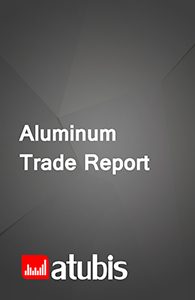Iran’s Aluminum Sheet and Plate Market Outlook Report
9,743€
- TRY: 475,000 ₺
A major portion of aluminum sheets and plates fall in the non-heat-treatable alloy category. Series 3xxx and 5xxx alloys take the largest market share. There are also series 1xxx alloy sheets and plates, mainly used in electrical applications. Aluminum sheets and plates are produced using cold and hot rolling, but there is only one hot-rolling plant in the country. There are fewer passes in the cold rolling process, which translates into less equipment required, lower capital intensity, and lower production costs.
Product Description
Packaging for chemicals and beverages, false ceilings, dampa ceilings and tiles, as well as composite panels are some of the main applications of aluminum sheets and plates. Thus, construction and packaging are the main consumers of these products in Iran. The packaging industry is expected to be able to maintain output levels during the sanctions owing to demand drivers from food, drugs, and chemicals. But the construction sector is forecast to grow.
With a GDP of $415 billion in 2019, Iran was the third largest economy in the region that year. While the country’s economy was steadily growing after the drop in 2012 due to the sanctions, it dipped once again in 2019 thanks to the return of the sanctions. Although the production of aluminum has a longer history in Iran compared to other countries in the region, it currently stands as the sixth largest producer on a regional scale. Nonetheless, as new aluminum smelters are commissioned in the country, it will definitely advance to the fifth place.
Market drivers of aluminum sheets and plates
Easy and quick installation, heat insulation (preventing energy loss), and self-cleaning properties are some of the advantages of using composite panels. Given that this type of façade is mainly used in commercial, non-residential buildings, demand for composite panels is expected to grow as non-residential construction increases in the country. A major portion of domestic demand for aluminum sheets is met through imports. The spike in exchange rates over the recent years has significantly reduced imports, creating an opportunity for domestic producers to boost operating rates. The IMF has forecast that by 2024, the USD to rial rate will grow by a factor of 2.5 compared to 2018. Given that outlook, aluminum sheet imports are expected to remain low.
While higher exchange rates put pressure on imports and created an opportunity for domestic producers, it also translated into higher prices for aluminum and aluminum products in the domestic market, leading to diminished buying activity, especially in a country where price is the most important factor affecting the market.
Overview of Iran’s aluminum sheet and plate market
Given that a considerable portion of Iran’s demand for aluminum sheets and plates is met through imports, the country’s trade balance has always been negative, meaning it is a net importer of flat aluminum products. Iran’s trade balance over the study timeframe was almost rangebound; net imports in the timeframe averaged 23,800 tonnes. China has been a major source of imports, which has further increased its share in Iran’s foil imports. Exports, on the other hand, constitute a small share of domestic output and are mostly sent to Iraq. The deficit in the country’s aluminum sheet and plate market is expected to shrink over the coming years, before rising close to historical averages later in the forecast period.
Breakdown of Iran’s aluminum sheet and plate market
Domestic demand for aluminum sheet and plate in the forecast timeframe as well as the previous period has been broken down using three factors. The first factor breaks down the market into three categories based on alloy material: commercially pure aluminum, heat-treatable alloys, and non-heat-treatable alloys. Past and future trends for each type of material have been analyzed. Non-heat-treatable alloys hold the largest share of the market. In the second breakdown, products are divided into two categories based on thickness: sheets (0.2mm to 6.0mm) and plates (more than 6.0mm), with sheets taking a major share of the market. Finally, using the third factor, aluminum sheets and plates are categorized based on their applications in different industries. The packaging industry and the construction sector are the largest consumers of aluminum sheets and plates in Iran.
Key players in Iran’s aluminum sheet and plate market
- Navard Aluminum MFG
- Pars Aluman Kar Company
- Aluminum Pars
- Razan Saaf
- Tabriz Aluminum Sheet (Vatco)
- Mesbar Kaveh
Additional Information
| Industry | Aluminium Flats |
|---|---|
| Region | Iran |
| Report Type | Industry Report |
Specifications
| Report Attribute | Details |
| The base year for estimation | 2021 |
| Historical data | 2011-2020 |
| Forecast period | 2021-2026 |
| Quantitative units | Value in USD and Volume in Tonne |
| Report coverage | Market Overview, Dynamics, Market Outlook, Risks to Forecast, Consumer Market, Industry Overview, Market Landscape, Competitive Landscape, Market Attractiveness, External Macro Environment Analysis |
| Segments covered | Composition, Type, Application |
| Pricing and purchase options | Please explore our purchase options to meet your exact research needs. |
Reasons to Buy
- Recognize the geographical distribution of import demand
- Identify the current and future key players of the trading market
- Achieve a better insight on potential target markets
- Understand the behavior of major suppliers/customers either globally or regionally
- Identify competitors as a feed for market analysis
Table of Content
1- Executive summary
2- Introduction
2-1- Objective
2-2- Market under study
2-3- Product
2-3-1- Product specifications
2-3-2- Consumption structure
2-3-2-1- Applications
2-4- Physical properties
2-5- Subjects discussed
2-6- Geographical scope under study
2-7- Study timeframe
2-8- Study currency
2-9- Potential audience
3- Market dynamics
3-1- Market drivers
3-2- Restraints
3-3- Opportunities
3-4- Challenges
4- Market overview
4-1- Market size
4-2- Industry capacities
4-2-1- Existing capacities
4-2-1-1- Capacity distribution
4-2-1-2- Geographical distribution of capacities
4-2-2- Future capacities
4-3- Output
4-3-1- Output trends
4-3-2- Operating rates
4-4- Consumption
4-4-1- Consumption trend
4-4-2- Consumption Share of domestic product
4-5- Trade
4-5-1- Exports
4-5-2- Imports
4-5-3- Trade balance
4-5-4- Market balance
4-6- Market breakdown by product type
4-7- Market breakdown by product type
4-8- Market breakdown by application
4-9- Inventory
4-9-1- Producers inventory
4-9-2- Consumers inventory
4-9-3- Traders inventory
5- Market outlook
5-1- Market factors
5-1-1- Raw materials
5-1-2- Costs and prices
5-1-3- Competition
5-1-4- The government
5-1-5- Other factors
5-2- Future scenarios
5-3- Risks to forecast
6- Consumer markets
6-1- End-user markets
6-1-1- Building construction
6-1-2- Infrastructure construction
6-1-3- Transportation manufacturing
6-1-4- Industrial equipment manufacturing
6-1-5- Durable goods manufacturing
6-1-6- Consumable goods manufacturing
6-2- Direct consumer markets
6-2-1- Major Direct consumers
6-2-1-1- Existing capacities
6-2-1-2- Drivers
7- Export potentials
7-1- Destinations
7-1-1- Trade and insurance costs
7-1-2- Import market suppliers
7-1-3- Producers potential share
8- Industry overview
8-1- Raw materials
8-1-1- The supply volume of raw materials
8-1-2- Supply channels of raw materials
8-1-3- Raw materials procurement costs
8-2- Cost structure of producers
8-3- Production cost curve
8-4- Industry value added
8-5- Generated new scrap
8-6- Technology
9- Market landscape
9-1- Domestic sales markets
9-1-1- Pricing in the domestic market
9-1-2- Potential domestic demand
9-1-3- Trade agreements for imports
9-1-4- Foreign suppliers
9-2- Foreign sales market
9-2-1- Prices
9-2-2- Potential markets overview
9-2-3- Trade agreements for exports
9-2-4- Foreign customers
10- Competitive landscape
10-1- Producers
10-1-1-1- Company profile
10-1-1-2- Revenue structure
10-1-1-3- Gross profit margins
10-1-1-4- Capacity, output and sales
10-2- Consumers
10-2-1-1- Company profile
10-2-1-2- Revenue structure
10-2-1-3- Gross profit margins
10-2-1-4- Capacity, output and sales
11- Market attractiveness
11-1- Industry rivalry
11-2- Threat of new entrants
11-3- Threat of substitutes
11-4- Bargaining power of buyers
11-5- Bargaining power of suppliers
11-6- Conclusion of Porter analysis
12- PESTEL analysis
12-1- Political factors
12-2- Economic factors
12-3- Social factors
12-4- Technology factors
12-5- Environmental factors
12-6- Legal factors
13- SWOT analysis
13-1- Large-scale companies with favorable conditions
13-1-1- Short-term strategies
13-1-2- Long-term strategies
13-2- Large-scale companies with unfavorable conditions
13-2-1- Short-term strategies
13-2-2- Long-term strategies
13-3- Small enterprises with favorable conditions
13-3-1- Short-term strategies
13-3-2- Long-term strategies
13-4- Small enterprises with unfavorable conditions
13-4-1- Short-term strategies
13-4-2- Long-term strategies
List of Figures
- Output and consumption; 2011-2020
- Market share of product applications; 2020
- Market surplus; 2019-2026
- Production process flowchart
- Market size; 2011-2026
- Existing capacity; 2011-2020
- Capacity distribution; 2020
- Geographic distribution of capacities; 2020
- Development of future capacity; 2011-2026
- Amount of output; 2011-2026
- Operating rates of production plants; 2011-2026
- Amount of consumption; 2011-2026
- Consumption share of domestic product; 2011-2026
- Exports of product; 2011-2020
- Imports of product; 2011-2020
- Historical trade balance; 2011-2020
- Future Market balance; 2021-2026
- Market output breakdown by alloy type; 2011-2026
- Market consumption breakdown by alloy type; 2011-2026
- Market balance breakdown by alloy type; 2011-2026
- Market output breakdown by product type; 2011-2026
- Market consumption breakdown by product type; 2011-2026
- Market balance breakdown by product type; 2011-2026
- Market consumption breakdown by application; 2011-2026
- Inventories of raw materials and products at producers factories; 2011-2020
- Consumers’ inventory of product; 2011-2020
- Traders’ inventory; 2011-2020
- Production forecast, according to raw materials and sales analysis; 2019-2026
- Market surplus; 2019-2026
- The share of end-user industries in the consumption; 2011 and 2020
- Changes in the end-consumption of extrusion products; 2020 vs 2026
- Applications in building construction industry; 2020
- Applications in infrastructure construction industry; 2020
- Applications in transportation manufacturing industry; 2020
- Applications in industrial equipment manufacturing industry; 2020
- Applications in durable goods manufacturing industry; 2020
- Applications in consumable goods manufacturing industry; 2020
- Capacity distribution structure of direct consumers; 2020
- Existing capacities of direct consumers in each province; 2020
- Suppliers of the export potential destination; 2020
- Historical exports to the export potential destination and future potential; 2016-2026
- Up-stream domestic supply; 2011-2020
- Raw materials domestic supply; 2011-2020
- Supply channels of producer plants
- Spot price of raw material in the market; 2011-2026
- Cash cost structure for production the product; 2020
- Production cost curve of the plants; 2020
- Gross value added of the industry; 2011-2020
- Generated new scrap; 2011-2020
- Sales channels
- Realized price of the product in the market; 2011-2026
- Potential demand of each province; 2020
- The main foreign suppliers to the market; 2011-2020
- FOB price vs domestic market; 2011-2026
- Map of global major importers > 20,000t; 2020
- Major foreign customers; 2011-2020
- Revenue structure of the producers; FY2020
- Sales income and gross profit margin of the producers; FY2011-2020
- Output and sales of the producers; FY2011-2020
- Revenue structure of the consumers; FY2020
- Sales income and gross profit margin of the consumers; FY2011-2020
- Output and sales of the consumers; FY2011-2020
- SWOT matrix for large-scale companies with favorable conditions
- Strategies positioning for large-scale companies with favorable conditions
- SWOT matrix for large-scale companies with unfavorable conditions
- Strategies positioning for large-scale companies with unfavorable conditions
- SWOT matrix for small enterprises with favorable conditions
- Strategies positioning for small enterprises with favorable conditions
- SWOT matrix for small enterprises with unfavorable conditions
- Strategies positioning for small enterprises with unfavorable conditions



